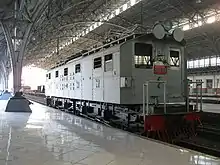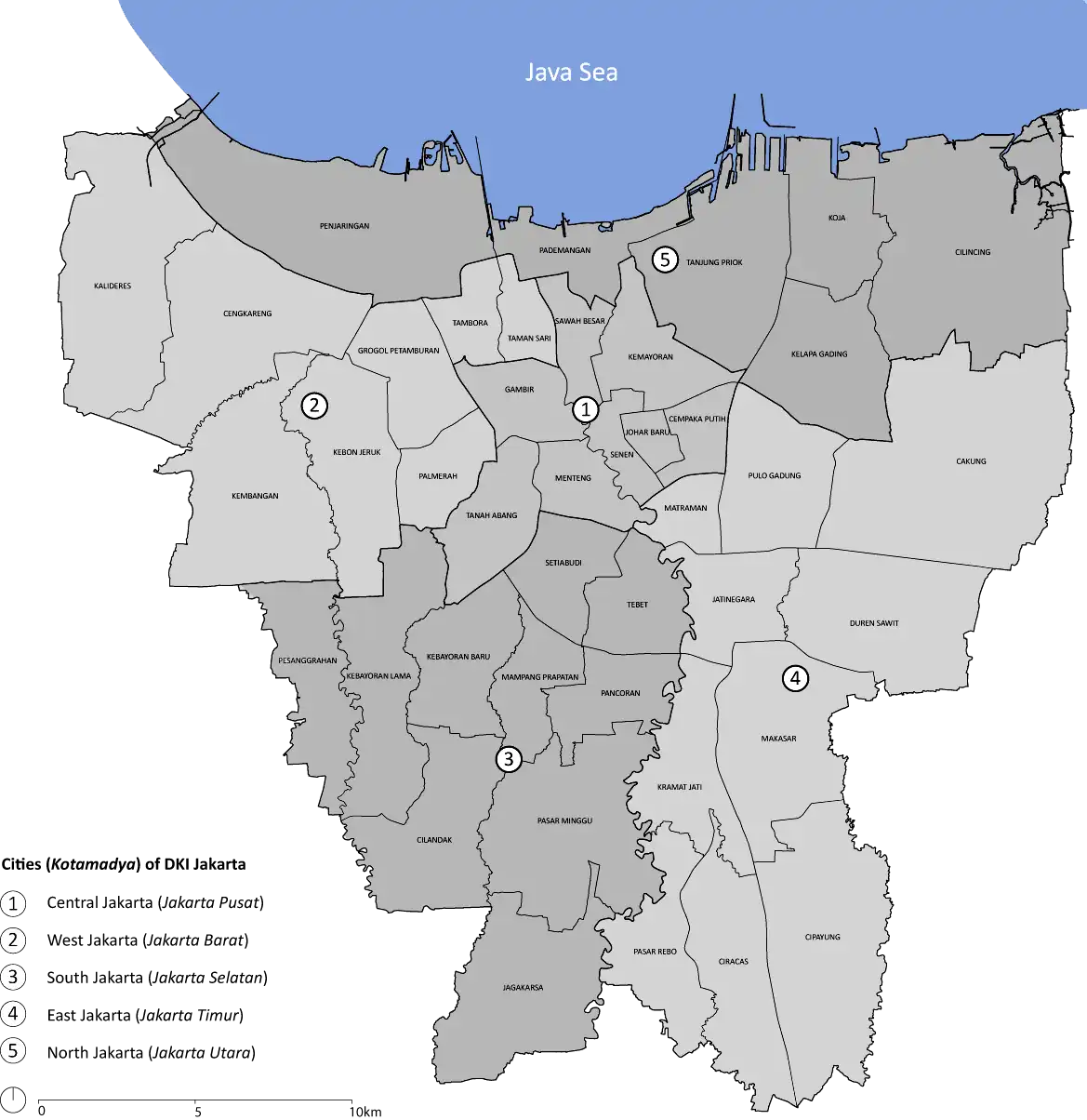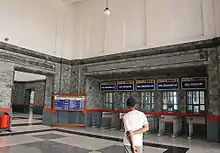Tanjung Priuk railway station
Tanjung Priuk Station (TPK),[1] is a railway station in Tanjung Priok, Tanjung Priok, North Jakarta. It is located across the Tanjung Priok Port, which is the main port of Jakarta. This station is one of the oldest in Jakarta and the biggest station built during the Dutch East Indies era. It is included in the list of heritage buildings by the government of Jakarta.

TP05 Tanjung Priuk Station Stasiun Tanjung Priuk | |||||||||||
|---|---|---|---|---|---|---|---|---|---|---|---|
 Tanjung Priuk Station, 2019. | |||||||||||
| General information | |||||||||||
| Location | Jalan Taman Stasiun Tanjung Priok, Tanjung Priok, Tanjung Priok, North Jakarta 14310 Jakarta Indonesia | ||||||||||
| Coordinates | 6.1111°S 106.8808°E | ||||||||||
| Elevation | +4 m (13 ft) | ||||||||||
| Owned by | Kereta Api Indonesia | ||||||||||
| Operated by | Kereta Api Indonesia Kereta Commuter Indonesia KAI Logistik | ||||||||||
| Line(s) | |||||||||||
| Platforms | 4 bay platforms | ||||||||||
| Tracks | 8 | ||||||||||
| Connections | |||||||||||
| Construction | |||||||||||
| Structure type | Ground | ||||||||||
| Parking | |||||||||||
| Accessible | |||||||||||
| Architect | C.W. Koch | ||||||||||
| Architectural style | Art deco | ||||||||||
| Other information | |||||||||||
| Station code | TPK • 0480[1] | ||||||||||
| Classification | II[1] | ||||||||||
| History | |||||||||||
| Opened | 2 November 1885[2] 28 April 2009 (reopened)[3][4] | ||||||||||
| Rebuilt | 6 April 1925[5] | ||||||||||
| Electrified | 6 April 1925[6] | ||||||||||
| Previous names | Tandjongpriok | ||||||||||
| Services | |||||||||||
| Passenger train: KRL Commuterline Freight train: Container train
| |||||||||||
| Location | |||||||||||
 Tanjung Priuk Station Location in Jakarta | |||||||||||
History
The history of Tanjung Priuk station is intertwined with the port of Tanjung Priok, the main port and gateway to Batavia and thereby of the entire Dutch East Indies.
First generation

In the past, Tanjung Priok was a dangerous forest and swamp, so a safe means of transportation was needed at that time (railway). At the end of the 19th century, the Sunda Kelapa port which was originally located in the area around the Fish Market was no longer sufficient, and the Dutch built a new port facility at Tanjung Priok. The port was built in 1877 in response to the increased maritime traffic accompanying the opening of the Suez Canal. Since Tanjung Priok is situated further away from Batavia than the old port of Sunda Kelapa, a railway was constructed linking Tanjung Priok to the city of Batavia in the southwest. This would provide a safe and comfortable means of transportation in the swampy area.[7]
The first Tanjung Priuk Station is located near the pier of Tanjung Priok Port. This station was completed by Burgerlijke Openbare Werken (BOW) or civil public works in 1883 and it was only on November 2, 1885 that its opening was inaugurated at the same time as the opening of Tanjung Priok Port. The first station opened to the quay immediately next to the first harbour.[8]
Furthermore, the operation of the Sunda Kelapa-Tanjung Priuk railway line was handed over to Staatsspoorwegen (SS). Until 1900, no less than 40 train trips per day for the Tanjung Priuk–Batavia SS/NIS and Tanjung Priuk–Kemayoran round trip routes.[9]
Second generation
With the increase of the port activity since the early 20th century, there has been an expansion of the port which caused the Tanjung Priuk Station to be evicted. SS then looked for vacant land next to the Lagoa warehouse to build a new station. SS assigned Engineer C.W. Koch as the main architect of the station.[9]
To prepare for the construction of the station, SS made a mock-up model of the new Tanjung Priuk Station. This mockup appears in the book commemorating the 50th anniversary of the SS by S.A. Reitsma.[10] SS then contracted a steel company named Machinefabriek Braat Soerabaia-Djokja-Tegal located in Ngagel, Surabaya to manufacture its overcapping roof frame.[11] At that time, the ruling Governor General was A.F.W. Idenburg (1909-1916). It takes about 1,700 workers with 130 of them being European workers.[9]
.jpg.webp)
This new station was opened to the public on April 6, 1925 which coincided with the launch of the first KRL route from Tanjung Priok to Meester Cornelis (Jatinegara). The first launch was also carried out to commemorate the 50th anniversary of the SS.[10] The station building is in the Art Deco style and has an area of 3,678 m2 (0.3678 ha), standing on an embankment area which covers 46,930 m2 (4.693 ha).[12]

With the completion of this station, the "wasting act" was committed by the SS. With eight lines and five platforms, this station is very large and since 1929 this station is almost as big as the Batavia-benedenstad station which has now turned into Jakarta Kota Station. Unfortunately, ships that dock at Tanjung Priok Harbor do not bring passengers to this station. This station later only became the terminus for KRL (electric commuter train) since 1925.[13]
This station is also equipped with temporary accommodation on the left wing of the building for passengers who will continue their journey by ship. With the opening of Kemayoran Airport which serves general flights, SS experienced a tough challenge considering that many passengers switched to airplanes. The location of Tanjung Priuk Station which is far from the port makes passengers reluctant to use the train, even though feeder buses are available.[9] World War II had a significant impact on SS railroad operations. During the Japanese occupation of Indonesia, this station was prioritized for war purposes and sent romusha out of Java.[9]
Present day

In the early 1990s, the Ministry of Transportation had planned to build a Jakarta outer ring rail network that would connect this station with Cikarang Station via Pasoso Station, but was diverted to Sungai Lagoa Station. One of the goals is to minimize freight trains crossing urban areas in Jakarta. At first the plan went quite well with the completion of the Citayam to Nambo railway network, but the 1997 Asian financial crisis made this plan stop halfway.[14]
Amidst the hustle and bustle of the port, the condition of the station building became increasingly unkempt towards the 21st century. Nonetheless, the elegance of this neoclassical, art deco and contemporary building has proven that in the 20th century, this station triumphed in its time. Indeed, at that time PT Kereta Api had deactivated the station for passenger service in early January 2000. The roof of the building is off; many of the glass is broken and many of the framework is rusty with age. The station platform and its emplacements are full of homeless people. In order to "patch up" the leaking revenue due to stowaways and losses due to the lack of revenue from platform tickets, PT Kereta Api leased out its station space as a warehouse for expeditions, ticket agents, and money exchange services.[9]
Concerned about this condition, PT Kereta Api decided to completely renovate the station. Preparations were carried out in November-December 2008 by carrying out a major physical renovation of the station building. Furthermore, the project continued with the rehabilitation of rail facilities and the construction of electrical signaling devices in early 2009. On 28 April 2009, this station was able to return to function and was inaugurated by President Susilo Bambang Yudhoyono, along with the inauguration of Terminal 3 of the Soekarno–Hatta International Airport.[3][15][4]
Building and layout

This station has eight train lines with line 2 as a straight line to Jakarta Kota, line 3 as a straight line from Jakarta Kota, line 6 as a straight line to Rajawali-Pasar Senen-Jatinegara, and line 7 as a straight line from Jatinegara-Pasar Senen-Rajawali. On the northwestern wing of the station emplacement there is a fork in the path to the port.
Even though this station is not a central station, it is quite modern because it uses an arc-shaped overcapping framework that covers the six railway lines. Steel structures became common on European stations in the 20th century. Windows in the form of lines consisting of horizontal roof profile trim and cornice holes, vertical lines and wall indentations, giving a graceful impression. Stained glass and ceramic profile ornaments give a grandiose effect and are strengthened by large and strong columns on the main porch and supported by stairs along the building.[9]
| G | South departure gate | |
| Station hall and east departure gate | Side platform | |
| Line 8 | - | |
| Line 7 | - | |
| Bay platform | ||
| Line 6 | Flat train car parking | |
| Line 5 | Flat train car parking | |
| Bay platform | ||
| Line 4 | Flat train car parking | |
| Line 3 | Flat train car parking | |
| Bay platform | ||
| Line 2 | ||
| Line 1 | and flat train car parking | |
| Side platform | ||
| G | North departure gate | |
Notes:
- Currently, Line 1 and 2 serves KRL Commuterline Tanjung Priok Line.
- Currently, Line 1, 3, 4, 5, and 6 are only used for flat train car parking (filled or empty).
Services
So far only a few long distance economy class trains depart/terminate at this station. Starting from 1 November 2014, Tanjung Priuk Station only serves freight trains heading from/to Tanjung Priok Port. All passenger trains that used to terminate here were rerouted to Pasar Senen.[16]
On 21 December 2015, the pink line to Jakarta Kota railway station was reopened, after being inactive for years.[17]
Commuterline
| Type | Route | Destination | Notes |
|---|---|---|---|
| KRL Commuterline | Jakarta Kota–Tanjung Priuk |
Freight train
- Container transportation: Swing point towards Pasoso or towards JICT Tanjung Priok Port:
- from and towards Kalimas
- from and towards Surabaya Container Terminal
- from and towards Indro via Kandangan
- from and towards Gedebage via Kiaracondong
- from and towards Lemahabang
- Container transportation: Transition point to Pasoso to take towards Sungai Lagoa:
- from and towards Kalimas
- from and towards Semarang Tawang
Supporting transportation
| Type | Station | Route | Destination |
|---|---|---|---|
| TransJakarta | Tanjung Priok | Tanjung Priok–PGC 2 | |
| 10D | Tanjung Priok–Kampung Rambutan | ||
| 10H | Tanjung Priok–Blok M | ||
| Pluit–Tanjung Priok | |||
| 10A (Non-BRT) | Tanjung Prok–Marunda | ||
| N/A | 10K (Non-BRT) | Tanjung Priok–Pasar Senen | |
| N/A | JAK-1 (MikroTrans Jak Lingko) | Tanjung Priok–Kebon Bawang | |
| JAK-15 (MikroTrans Jak Lingko) | Tanjung Priok–Segaramakmur, Bekasi | ||
| JAK-29 (MikroTrans Jak Lingko) | Tanjung Priok–Sukapura | ||
| JAK-77 (MikroTrans Jak Lingko) | Tanjung Priok–Sunter Agung | ||
| JAK-88 (MikroTrans Jak Lingko) | Tanjung Priok–Ancol | ||
| JAK-117 (MikroTrans Jak Lingko) | Tanjung Priok–Tanah Merdeka | ||
| DAMRI | Tanjung Priok–Soekarno–Hatta International Airport[18] | ||
| Transjabodetabek | AC25 (Mayasari Bakti) | Tanjung Priok–Bekasi | |
| AC42 (Mayasari Bakti) | Tanjung Priok–Cileungsi | ||
| x1 (Kramat Djati) | Tanjung Priok–Baranangsiang, Bogor | ||
| x2 (Kosub Bersama) | Tanjung Priok–Cibinong | ||
| x3 (CBU) | Tanjung Priok–Leuwiliang | ||
| Angkot & Mikrolet (share taxis)[19] | U01 | Tanjung Priok–Pulo Gebang | |
| U03A | Tanjung Priok–Pulo Gebang (via Cakung–Cilincing) | ||
| U05 | Tanjung Priok–Cilincing (via Lagoa) | ||
| U06 | Tanjung Priok–Alur Laut (via Pasar Koja, Walang) | ||
| U07 | Tanjung Priok–Pegangsaan Dua | ||
| U08 | Tanjung Priok–Rorotan | ||
| U09 | Tanjung Priok–Kramat Jaya (via Walang, Pasar Lontar) | ||
| JU02 | Tanjung Priok–Pasar Embrio | ||
| JU02 | Tanjung Priok–Rawa Badak Utara | ||
| JU04 | Tanjung Priok–Sunter Agung | ||
| M14 | Tanjung Priok–Cilincing (via Jampea) | ||
| M15 | Tanjung Priok–Jakarta Kota Station (via Kampung Bandan Raya) | ||
| M15A | Tanjung Priok–Jakarta Kota Station (via Gunung Sahari–Mangga Dua Raya) | ||
| M30A | Tanjung Priok–Pulo Gadung | ||
| M49 | Tanjung Priok–Sunter Agung |
In popular culture
Tanjung Priuk Station is often used as a shooting location for music videos, movies, soap operas, and commercials.[20] Several titles of soap operas and songs whose music videos have used filming locations at this station include Dia Bukan Anakku (RCTI, SinemArt), "Menunggumu" sung by Chrisye featuring Peterpan (now named Noah),[21] "Ku Tetap Menanti" created by Eka Gustiwana sung by Nikita Willy, and "Dengan Nafasmu" by Ungu.[22]
Photography prohibition
Since the commercialization of Tanjung Priuk Station through commercials, television shows, and music videos filming, this station is now a very strict place for novice and experienced photographers because this place is prohibited as a photographing area, even though there are absolutely no signs prohibiting taking pictures. at Station. The reason for the cultural heritage status of this station is "never implemented" at other sites managed by the local government or BPCB.[23] Taking an SLR camera (including DSLR and mirrorless) or pocket digital camera on several occasions can be warned by security officers. Since the enactment of the new photographing rules at Commuter Line KRL stations, only cell phone cameras, pocket cameras, SLRs and action cameras (GoPro) are allowed to be used to photograph stations.[24]
References
- Buku Informasi Direktorat Jenderal Perkeretaapian 2014 (PDF) (in Indonesian). Archived from the original (PDF) on 1 January 2020. Retrieved 12 April 2023.
- Perquin, B.L.M.C. (1921). Nederlandsch Indische staatsspooren tramwegen. Bureau Industria.
- "Cita-cita, Bikin Statiun Pintar KA". www.jpnn.com (in Indonesian). 28 April 2009. Retrieved 23 June 2020.
- Mediatama, Grahanusa (28 April 2009). "Presiden Resmikan Terminal Tiga Soekarno Hatta dan Rehabilitasi Stasiun Tanjung Priuk". kontan.co.id (in Indonesian). Retrieved 23 June 2020.
- Reitsma, S.A. (1925). Boekoe peringetan dari Staatsspoor-en-Tramwegen di Hindia Belanda. Weltevreden: Topografische Inrichting.
- "Awal Mula Jalur Layang Kereta di Indonesia - Historia" (in Indonesian). Hendaru Tri Hanggoro.
- "Tanjung Priok, Stasiun", Jakarta.go.id, archived from the original on 23 February 2015
- Perquin, B.L.M.C (1921). Nederlandsch Indische staatsspooren tramwegen. Bureau Industria.
- Murti Hariyadi, Ibnu; Basir, Ekawati; Pratiwi, Mungki Indriati; Ubaidi, Ella; Sukmono, Edi (2016). Arsitektur Bangunan Stasiun Kereta Api di Indonesia. Jakarta: PT Kereta Api Indonesia (Persero). pp. 15–24. ISBN 978-602-18839-3-8.
- Reitsma, S.A. (1925). Boekoe peringetan dari Staatsspoor-en-Tramwegen di Hindia Belanda. Weltevreden: Topografische Inrichting.
- Sleeswijk, Wegener (1929). "Uitbreiding van de Spoorwegen in en om Batavia en Tandjong Priok". De Ingenieur. 1 (2): 1–12.
- Widayanti & Widyarsih 2012, p. 9.
- Majalah KA. August 2014.
- W, Kevin (4 April 2015). "Sejarah dan Drama di Balik Pengoperasian KRL Jalur Nambo". KAORI Nusantara (in Indonesian). Retrieved 5 March 2023.
- "Presiden: Tata Lahan Sepanjang Rel KA". Gatra. 28 April 2009. Archived from the original on 29 April 2020. Retrieved 5 March 2023.
- Rachman, Taufik (13 November 2014), "Stasiun Tanjung Priok Fokus Kereta Barang", Republika, retrieved 17 January 2017
- Agustinus, Michael (21 December 2015), "KRL Kota-Tanjung Priok 'Hidup Lagi'", Detik.com, retrieved 17 January 2017
- "Jadwal Bus Damri Dari Dan Ke Bandara Soekarno Hatta Jakarta". BusBandara.com (in Indonesian). 13 December 2014. Retrieved 5 March 2023.
- "Mikrolet – TransportUmum – Jakarta". www.transportumum.com (in Indonesian). Retrieved 5 March 2023.
- "Menanti "Stasiun Eropa" Bantu Atasi Macetnya Tanjung Priok". KOMPAS.com (in Indonesian). 28 July 2013. Retrieved 5 March 2023.
- Endah, A. (2007). Chrisye: Sebuah Memoar Musikal. Jakarta: Gramedia Pustaka Utama. p. 372. ISBN 9789792226737.
- "Ungu Syuting Video Klip Album Religi Ketiga". liputan6.com (in Indonesian). 8 August 2008. Retrieved 5 March 2023.
- Digest, Railway Enthusiast (28 September 2016). "[Opini] 71 Tahun KAI, Mau Dibawa Ke Mana?". Railway Enthusiast Digest (in Indonesian). Retrieved 5 March 2023.
- Adhari, F. (31 March 2017). "Jangan Takut Diciduk, Kini Stasiun Aman Untuk Kegiatan Fotografi!". KAORI Nusantara (in Indonesian). Retrieved 5 March 2023.
Cited works
- Widayanti, Rina; Widyarsih, Meyka (2012). "Analisis Perkembangan Gaya Arsitektur pada Fasade Bangunan Stasiun Kereta Tanjung Priuk". Jurnal Ilmiah Desain & Konstruksi. 11 (2). ISSN 2089-807X.
_(titel_op_object)%252C_NG-2002-84-E-28.jpg.webp)